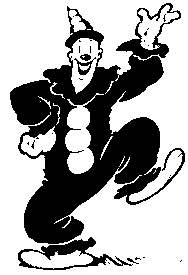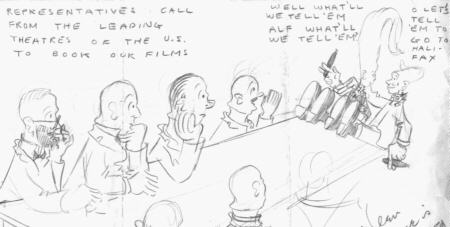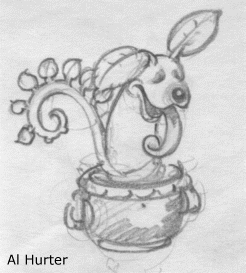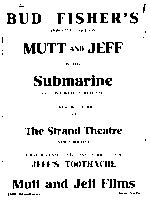
.
![]()
![]()
![]()
![]()
![]()
![]()
![]()
![]()
![]()
![]()
![]()
![]()
![]()
![]()
![]()
![]()
![]()
|
Contents
•
WARD KIMBALL's introduction at the 1978 Annie Awards (Anim
. P. 1) |
PIONEER PORTRAITS
by Dick Huemer
The modest little sign on a two-storied wooden building, cater-cornered from Fordhan University in the upper Bronx of New York, read simply:
RAOUL BARRE. Cartoonist*
|
*Pronounced "Barry" |
For months I had passed it almost daily, trying to get up enough nerve to mount the stairs and ask this Mr. Barre, cartoonist, for a job. Finally one fateful day, I "goided up my lerns" (I still retained my Brooklyn accent) and did it.
The dark chubby man with the smiling gray eyes who looked up from his desk completely disarmed me. I found it quite easy to say, "I would like to be a cartoonist."
In what I recognized to be some kind of a French accent, he said, "So. You would lak these jub, eh?" Later I learned that the accent was French Canadian.
That was all there was to it. In a short while I was in one of two small adjoining rooms, getting in my first licks as a cartoonist. I was put to work painting black shoes, coats and top hats on a character I knew from the comic pages as Jeff, of the firm of Mutt and Jeff. Of course I quickly Learned that I was not so much a cartoonist as a practitioner in the mysterious art of animation. And mysterious it certainly was. This was in 1916 B.D. (before Disney.) Comparatively few people had ever heard of animated pictures, much less ever seen any. The very term itself -- ANIMATOR -- was not in the ordinary person's lexicon. I remember when my father somewhat dubiously told a neighbor that his son, the ex-art student, was now an Animator, that grossly uniformed individual asked in all innocence, "He's doing something with animals? Working for the S.P.C.A. -- or the circus?"
Actually, I was not yet an Animator. It took a whole month before I graduated to that elevated station. They were indeed hard up for recruits in this toddling business. At first I was what Barre in his quaint accent called "a THRASER." That is, a TRACER, one who followed up the animator and traced in the parts he left out that didn't change in the action. This was an archaic process entirely different from the present day CEL system, and too complicated to fully explain here. The best that can be said for it is that it was fun. We animators inked directly on paper, which afforded us a lot of creative freedom and the opportunity to express our own techniques and individuality. We were all enamored of Heinrich Kley. It never occurred to us that uniformity in appearance was a desirable thing. But this is something that the cel system later accomplished automatically.
|
The dialogue balloon animated up, remained long enough to be read, then exploded or whirled away. While it was held, only the character's mouth animated in a simple 3 drawing cycle with no attempt to form words or syllables, as was necessary later when sound came in.
Drawing by RMH, 1969 [Javascript effect] |
 |
Barre was a good man to work for. An artist himself, a fine arts painter rather than a cartoonist, he had a deep devotion to the nascent business. And it was just barely that, especially from an economic standpoint. You certainly couldn't in those days call it an art form. But long before Disney, he had the idea of plowing back what profits he made (and they were indeed miniscule) to produce better pictures, create a demand for them, and thus make more money for all concerned, artist as well as producer.
In his extremely limited way, he did what he could to further this end. For instance, he organised art classes for after-hours studies, where the animators could improve their skills by drawing from the live models which he supplied free of charge. This is something which Disney also did so many years later.
There is an amusing incident in connection with this. One night, right in the middle of the session while everyone was scratching away industriously, the model suddenly got down off her stand and flounced out of the room - anyway, as much as a gal with out any clothes on can be said to flounce.
Barre, as much astonished as any of us, immediately followed her. And for a while we could hear them arguing back and forth, although we couldn't make out what was said.
After a while, Barre came back with an amused smile on his rotund face and told us that classes were cancelled for that evening. Then he looked significantly at Vet Anderson. Vet, so-called because he was a veteran not of the Civil War but the Spanish American, was a well-known cartoonist of the early nineteen hundreds. His drawings appeared in such magazines as Puck, Judge and Life. He had now given that all up and turned to the new animated cartoons.
We all laughed when Barre told us it was all on account of Vet. "It's that man," she had said angrily. "He sits there drawing with that evil smirk on his face. What kind of a place is this anyway? Are you artists or a bunch of lechers who only want to look at a naked woman?"
Nothing that Barre could say had convinced her that Vet couldn't help himself, that he always wore that satyric leer when he concentrated. It was a peculiarity like that way he kept his pipe tobacco loose in his pockets. Intense participation distorted his features the way a violinist will grunt to himself while deeply engrossed in his playing.
At any rate, Barre could not persuade the gal that we weren't all a passel ofvoyeurs. And when she had her clothes back on and her fee collected, she really did flounce. I must add that notwithstanding Vet's continued presence at future drawing sessions we never again had that same difficulty with any of the models. Probably she was an amateur. But I do remember that she had a fine figure.
Another thing Barre tried hard to improve was the stories. The idea of story boards was far in the future, awaiting the Disney Era.
At best, very little time could be allotted to the story phase of the operation, since the most important thing was how much footage could be ground out every week. But he did what he could, and saw to it that there was at least some delineation of the action and plot before animation was begun instead of leaving the whole thing up to each animator to invent and improvise as he went along. While the dual role of storyman and animator was fun for the artist, it scarcely made for a complete and well-rounded story line. Frequently the picture would end with some hastily contrived gimmick, or the all-too-often iris down on the character running towards the horizon. For when the very strict footage limitations had been reached or the time allowed for production had been used up, whichever came first, it was THE END.
But even though his pictures did improve perceptibly (to us; alas! not to audiences) it wasn't in the cards for Raoul Barre to be the savior of the hand-drawn films. That honor almost fell later to Paul Terry and his Aesop's Fables, which is another story, as is that of Walt Disney who really did finally put animated cartoon films on their feet (no pun intended.) Ironically, Walt had also determined that the story was the key to the whole thing.
At any rate, Barre did not have much time left to devote to his beloved business. And his end was not a happy one. Worried mostly by financial difficulties involving the studio and his newly acquired partner, Charlie Bowers, his mind gave way under the strain. They say he was found wandering in a park, babbling incoherently and tossing money to the four winds. The last may be an embellishment of the story which is tragic enough. I had the whole tale second hand. So poor, kindly, well-meaning Raoul Barre was committed and not long after I heard that he had died. This happened in the early 1920s and I was greatly saddened by the event.
A word about Bud Fisher, the creator of the Mutt and Jeff strip. Fisher was not a pioneer of the Animation industry except in the sense that he financed the operation of Barre's studio. Other than that he took no part in the production. In fact we seldom saw him. My last impression of him was his flashing through the studio in his natty Captain's uniform. He was off to World War I from which he returned safe and sound and not a whit less wealthy. Fisher had a flair for making money. I heard that he made plenty of profit from the cartoons we scrimped and labored to grind out.
I don't think there was very much left for Barre to pocket. He was paid a flat sum for delivering a half reel print and negative. The amount was in the neighborhood of $1,500. Since we turned out a picture every week, that sum represented the sole income of the studio. It appears ridiculous by modern standards but it was enough to pay the salaries of five or six animators, about ten tracers, one cameraman and a cel washer. We certainly couldn't afford to buy new eels for each picture.
Despite the horrendous schedule which often kept the staff working overtime so as to get the pay-roll check from Bud Fisher's attorney (and I might add we worked overtime without recompense) we animators did manage to carry on a personal campaign of improvement and inventiveness, each according to his lights.
I recall the expressions of admiration, mixed with not a little envy, evoked by a short piece of animation in one of the early Mutt and Jeffs. It was of a billy goat by one John Rigby who soon after his heady success, however, dropped completely and permanently out of the animation business. Maybe he figured he could never top it. I can still savor my amazement of his wonderful accomplishment even though I know as well as I know God made little green apples that it was, by today's standards, infantile and crude and atrociously drawn and no more lifelike than a paper doll.
Another milestone that comes to mind is to the credit of Albert
Hurter. If that name has a familiar ring it is because for many
years, from about 1931 until he died of heart disease in 1938, he was
one of Walt Disney's paladins. Albert was a superb sketch artist
whose proficiency with the pencil (he never used any other medium)
was surpassed only by one of the most bizarre and fertile
imaginations I have ever encountered in or
|
out of the animated cartoon business. The book of his collected drawings, "He Drew As He Pleased," gives only an inkling of what he had to contribute to animation. Disney had the very good sense to use Albert, not as an animator, but as an innovator and sketch artist. He gave him a free hand and all day long Albert sat at his board, puffing on black cigars and letting his mind run riot over the paper.'At the end of the day he would have a tray full of |
|
But when he worked at the Mutt and Jeff studio, Albert was an animator. It would never have occurred to anyone to use him in any other way even though we all appreciated his magnificent drawing ability. Who could have afforded it anyway? Nor was he an outstanding animator except for the one incidental bit I have in mind. I think we were working on a submarine picture which required an American flag. But instead of the usual economical three or four drawing reverse and repeat cycle, Albert who happened to look out of the window and see a flag fluttering in the breeze, studied it and imitated it in animation, and when the finished cartoon was viewed for the first time in our projection room there wasn't a dry eye in the house. Oh I'm exaggerating all right, but only to try to give some idea of how wonderful we thought that bit of animation was. Albert had done a new and brilliant thing. He had animated from life.
|
|
I recall trying a few innovations myself. A particularly outlandish one resulted from my continual search for new ways to register a "take." I finally achieved the ultimate. All the features of Mutt's face -- eyes, ears, nose, eyebrows, mouth, yes even his moustache -- whirled off, circled wildly around his head and then smacked back into place. I never was able to top that, although I did seriously consider having all the flesh, hair and features do a similar aerial rigadoon around his bare skull. I wisely refrained. |
And then there was the time I again tried to prove the point that in very fast action it didn't matter too much what the inbetween drawings looked like. I sneaked in a little experiment which finally got on the screen. As I recall, the action was of a bottle flying across the scene. Spaced here and there between legitimate bottle drawings I had inserted a shoe or an alarm clock. When the finished scene wasprojected, it was impossible to discern that it wasn't a perfectly legitimate piece of animation, and that ANYTHING BUT A BOTTLE HAD FLOWN THROUGH THE SCENE. Naturally in a slow action such a procedure would be out of the question.
Walt Disney's conception of the Multiplane camera which achieves a feeling of depth and naturalness in his feature cartoons was anticipated in effect way back before the twenties by Carl Lederer. Carl's idea did not involve the camera. It would have been simply unthinkable from an economic stand point, even if he had thought of it. Solely from a mechanical angle, Disney's invention is not only elaborate but very expensive. What Carl had in mind was to get the sensation of depth by drawing the whole thing out on paper.
When Lederer explained his idea to Barre, that forward-looking producer encouraged him to go ahead with it. In those days a simple panorama was moved behind the cartoon character as he ran or walked in one place, similar to the painted scenery in the well-known Keystone Cop panorama chases.
What Carl finally did was to make a hook-up repeat of about 25 drawings of a city scene. This scene consisted of three separate levels of buildings, one behind the other and moving slower as they receded into the distance. I won't go into the technical process that required Carl to laboriously trace the three different speed levels on to each of the 25 finished cycle drawings. To us, the effect was sensational. We used it over and over until it finally wore out.
Carl Lederer also had the dream of making a serious, well-drawn semi-feature cartoon about Cinderella. I can still picture this nice-looking earnest young artist hunched over his animation board, plugging away, eternally puffing on an old pipe, never skylarking or kidding around the way the rest of us did. But pneumonia cut short his dreams of something a little better in the animation game.
The feature cartoon was to await the coming of the great Magician from Missouri.
--© Cartoonist Profiles, 1(3):14-18, Summer 1969

Pencil sketch dated 10/21/18, by "Alf". RMH had big hair then.



